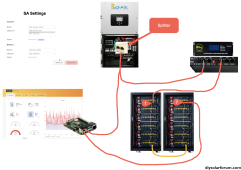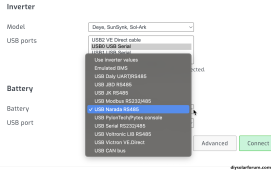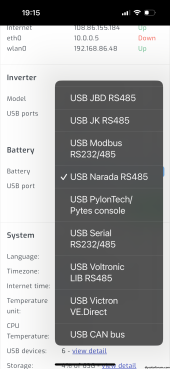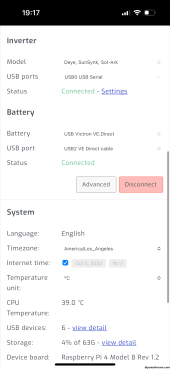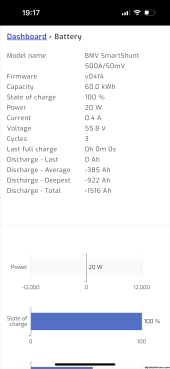A couple points of clarification for consideration.
- Solar Assistant (SA) can only communicate with one source at a time for battery information. If I want to view the data from the Victron shunt, I have to stop the connection in SA, and switch the USB input selection to the port the Victron is connected to. Afterward, if I want to flip back to direct communication with the EG4 batteries, I have to repeat the same steps forgoing active communication with the Victron. Basically, it's one or the other, multiple simultaneous battery measurement sources cannot be monitored at the same time (maybe SA will add this in the future, but I have no awareness of whether it could be included in their upcoming development plans).
- If you want to see the individual battery data in SA, you can only do this by directly getting the data from each battery. SA cannot parse the aggregate battery data communicated to either the ComHub or the Inverter into individual battery data.
Let me see if I have this right.
PREMISE_1:
For SA to "read" Inverter information, it requires a data connection at/near the Inverter comm port.
PREMISE_2:
For SA to "read" Battery information, it requires a data connection at/near the string of batteries, ideally at one "end" of the string.
OBSERVATION:
Some combinations of Inverters and Batteries require an intermediate "Communication Hub" for the former to read and direct the latter.
SUB-PREMISE_1 Not all information available either destination survives the transit through the hub.
QUERY_1
Is there any difference in the information available at the proximal and distal ends of the string of Batteries? If so, what are those differences?
QUERY_2:
If not, wouldn't a splitter placed at the proximal end of the Battery string (i.e., between the Batteries and the Hub/Inverter) achieve the same data result as having the data connection at the distal end of the string (at Battery #7 in your set-up)?
RELATED QUERY:
If no Hub was required between the Inverter and Battery string, would the single splitter adjacent to the Inverter be able to read all the Inverter information AND all the Battery information? If not, why not?
Separately, what is the difference to SA from reading Inverter data and the Battery string data (presumably at once) and being able to read the Shunt data? (Wherein your example, it would read, presumably Inverter data and Shunt data at once). Is there something categorically different in the data, as processed by the Pi, that makes "Inverter/Battery" or "Inverter/Shunt" work, but not "Battery/Shunt" or "Inverter/Battery/Shunt"?
I don't yet own any of the aforementioned equipment, but have been researching for awhile now. I have started collecting the software components to mock-up various configurations in an emulation environment, so I want to learn as much as I can about the physical constraints and practical limitations on linking various components together before I spent a ton of money buying hardware/equipment (that may not behave as nicely as a software emulation).
Sorry for the length of this post, but inquiring minds want to know.
MDS
